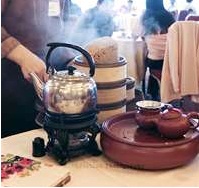“Dim Sum” , “Yum Cha” , “Morning Tea” or “Zao Cha”
Drinking Tea has always been an important part in the daily routines of most Chinese people, but Morning Tea specifically has been enjoyed by Cantonese Chinese for hundreds of years. Nowadays Morning Tea, Yum Cha, or Zao Cha are all ways to describe the activity Westerners might call “Brunch”, and Dim Sum refers to the dishes that are served at this leisurely mealtime. As with much international Chinese culture, this tradition has it’s roots in Guangdong province, but is practiced regularly throughout Hong Kong, Macau, Singapore, and Chinatowns worldwide. Let’s take a look at what’s in store for first-time morning tea patrons!

Kungfu Tea at your Table
Kung fu Tea
Don’t miss the chance to Pao Cha with your hosts while you sip on piping hot kung fu tea in small tea cups. All Morning Tea establishments provide the option of small tea sets with boiling hot water that you can use to make tea at your table. Sometimes the tea alone costs as much as the food, but worth it for first-time visitors. A common favorite among Cantonese is Pu-er tea, which is a darker tea that reminds me of coffee. It’s known for aiding disgestion and doubles as a dieting tea.
An alternative to Kung Fu tea is just a simple pot of house brew that varies place to place. The cups are usually bigger too.
Steam Baskets

Dim Sum Buffet
Tea isn’t complete without a variety of Dim Sum. There are really too many options for me to list them all here, but most of them include dumpling-sized morsels served 3 or 4 in a basket. They include, but are not limited to: pork and shrimp dumplings, char siu buns, meat and vegie pot stickers, xiao long bao, man tou, chicken claws, steamed meatballs, spare ribs, sticky rice in lotus leaves, taro dumplings, turnip cakes, spring rolls, tofu skin, egg tarts, mango pudding, red bean buns, and much much more.
These dishes are hard to miss because they are served in iconic bamboo steam baskets. These are all collectively refered to as “Dim Sum”.
Porridge/Congee

Congee with Preserved Eggs
Soups, porridge, and congee are all very important too. In my humble opinion, Morning Tea isn’t complete without a choice of Congee (very wet cooked rice), which is best with pork slices, chives, ginger, and preserved eggs. Sometimes congee looks unappetizing, but I guarantee you will not regret trying it. You might come to love it, just as I did.
Deep fried bread is often used to accompany congee. Use the fried bread sparingly, as it isn’t a particularly healthy choice.
Other dishes

Sauteed Green Vegies
Besides the standard components of Morning Tea that I’ve mentioned above, you can also order full dishes that you might expect in Chinese restaurants, including boiled chicken and garlic or wok-fried bai cai with soy sauce. It’s always a good idea to order an extra full-sized dish just in case the dim sum doesn’t fill you up.
~
That’s Morning Tea in a nut shell! Visit the links in this overview to learn more about the different parts of this traditional Chinese brunch and leave comments here after you try dim sum where ever you are!

 Custom Search
Custom Search